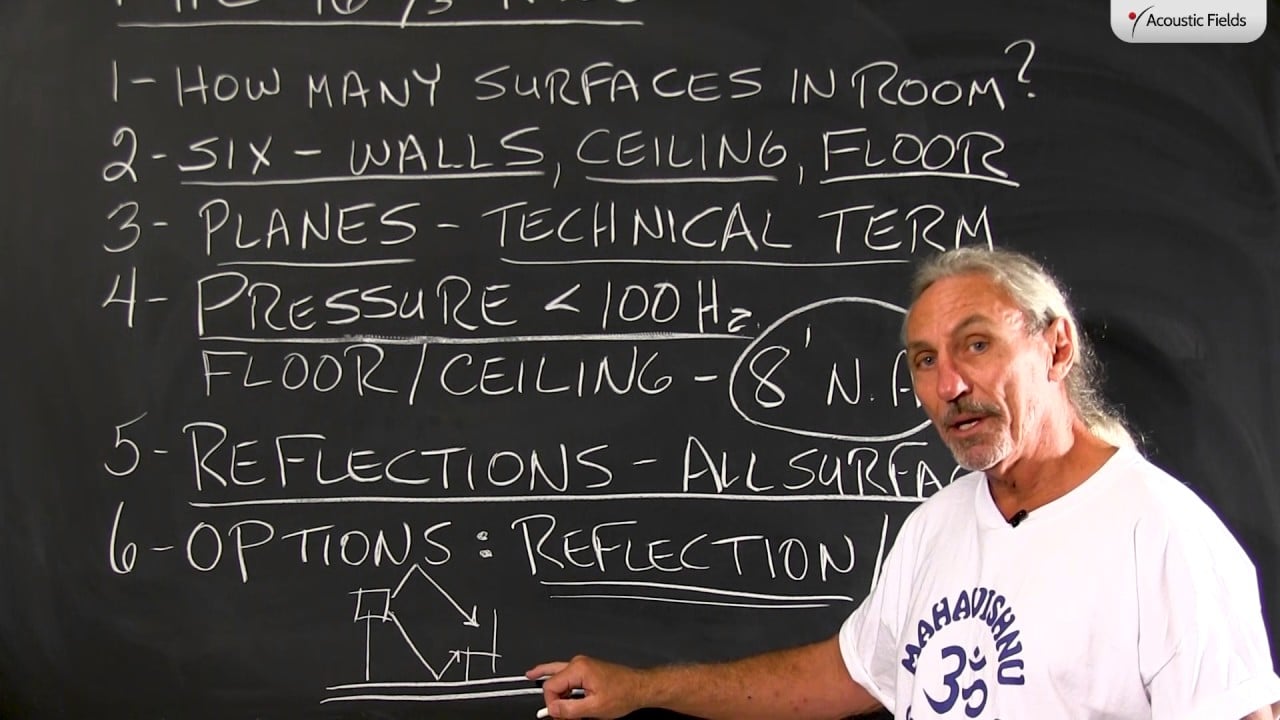Let’s talk about what I call the 16 2/3 %, I guess we could put % up there rule and basically it’s talking about the surfaces of the room. We spend a lot of time focusing on sidewalls, we spend a lot of time focusing on front walls, rear walls, ceiling not so much and we never, never, never talk about the floor. But what we have to realize is that we have six surfaces within our room and those planes all have an impact on the sound.
Now, for purposes of discussion, let’s assume they’re all equal in impact which they’re really not because it’s all dependent on usage and pressure. But we really have walls, ceiling and a floor. And we want to keep all those surfaces in mind when we’re treating. Now, I know we all have budgets that we have to stick to and we all have a certain amount of money that we can spend on a project. So the floor is kind of the last consideration and so is the ceiling. But those are really important elements that we have to see. And we have to consider those when we’re planning any kind of audio project.
So planes obviously is the technical term where everything intersects, it’s called a plane. So let’s look at the – woops, that’s not a good sound – let’s look at the pressure below a 100 cycles. Now, where is that mainly? In North America here we’re always faced with that 8-foot ceiling. Now, sometimes it’s a drop ceiling and there’s actual physical structure above it. But in North America we always have these 8-foot ceilings and I can’t think of a worse dimension in acoustics than 8 foot. We build rooms all the time and we don’t even start at 8, we start at 11 and go up and ideal is 14. And there’s all kinds of reasons for that which we’ll cover in another video but…
The pressure between the floor and the ceiling because the 8 foot is usually the smallest dimension. Our width is usually larger than 8 foot and our length hopefully is way longer than 8 foot. So the floor to ceiling dimension is the biggest problem that we have. And we all know that that pressure below a 100 cycles is maddening and difficult to treat, it takes a lot of square footage to treat. So that’s what we have to consider.
Now, reflections come off all surfaces. So if we’re sitting in our chair the surface that we’re close to the most, we have our speaker up here, is the floor. So we have floor reflections, we have ceiling reflections and those are the reflections that arrive at our ears before the lateral or sidewall reflections, before the front and the rear. So we have to be considerate of what material we’re going to make the floor out of.
Now, when we do our designs I always save the floor and the ceiling for the last because those give us surface areas that we can fine-tune, maybe what we’ve missed with the 4 walls. So it’s not our initial primary concern but it’s a concern that we always have to keep in the back of my mind when I’m doing design work. So what are our options here? Well, we have reflection. It’s going to be hard to put diffusion on the floor. We’d have to have a lot of objects scattered around and that wouldn’t be good, we’d be tripping and falling.
So we have reflection off the floor surfaces and then we have absorption which we can use to treat the reflections. So everything we do to the floor matters. You can really impact sound quality with the arrangement of materials you use in the floor. So that’s a discussion for another time. We just finished a studio in Los Angeles, give you an idea, and we did a 12 inch poured concrete slab on springs because earthquakes. So all kinds of ways that we have to do and then in top of the 12 inch we had numerous layers of material.
So depending on usage, depending on objective, depending on location the floor is very, very critical. So just remember, with the 16 2/3 rule, every surface or every plane is important.
—
This is an unedited transcript from our video series from Acoustic Fields. There will be some errors in grammar and sentence structure that occur during this translation process.
For complete understanding and comprehension, please view the video which is included in this text. For any additional information regarding this topic or others relating to room acoustics, please contact us directly at:
P: 520 – 392 – 9486







